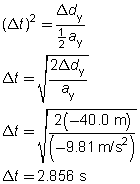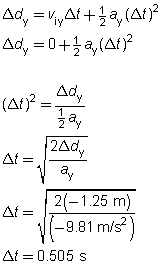Module 2—Motion in Two Dimensions
Solving Projectile Problems: Calculating the Time of Fall and Horizontal Displacement (Range) of a Projectile
The following problem and solution is an example of how these projectile motion problems can be solved. Following this example, you will be asked to solve several of this type of problem for your assignment.
Question
A ball is fired horizontally at 15.0 m/s from a vertical height of 40.0 m. How long will it be in the air? How far away, horizontally, will it be when it lands (horizontal range)?
Given
vertical case
ay = –9.81 m/s2
vyi = 0.00 m/s
Δdy = –40.0 m
horizontal case
ax = 0
vxi = 15.0 m/s
Required
the time the ball remains in the air (Δt)
the horizontal range of the ball (Δd)
Analysis
This might seem like a difficult two-dimensional problem. However, knowing that the vertical motion of the ball is independent of the horizontal motion, the question becomes two separate one-dimensional problems:
- determining the vertical motion with constant acceleration
- determining the horizontal motion with uniform velocity
To determine the vertical motion with constant acceleration, only vertical information will be required to solve the time of fall.
To determine the horizontal motion with uniform velocity, only horizontal information will be required to solve the horizontal displacement (range).
Solution
The equation for vertical displacement can be used to calculate the time of fall.


It takes 2.86 s for the ball to fall.
The equation for horizontal uniform motion can be used to find the range.
Δdx = vxΔt
= (15.0 m/s)(2.856 s)
= 42.8 m
Paraphrase
The ball lands 42.8 m from the launch position.
 Self-Check
Self-Check
SC 4. Answer practice problem 1 for “Example 2.10” on page 107 of your textbook.
 Self-Check Answer
Self-Check Answer
SC 4.
Given
horizontal case
ax = 0
vxi = 30 cm/s
vertical case
ay = –9.81 m/s2
vyi = 0.00 m/s
Δdy = –1.25 m
Required
the horizontal range of the coin (Δd)
Analysis and Solution
Even though the time that the coin remains in the air (Δt) is not asked for, solve for it first so that the range can be determined.

It takes 0.505 s for the coin to fall.
The equation for horizontal uniform motion can be used to find the range.
Δdx = vxΔt
= (30 cm/s)(0.505 s)
= 15 cm
Paraphrase
The coin lands 15 cm from the base of the table.
 Module 2: Lesson 3 Assignment
Module 2: Lesson 3 Assignment
Remember to submit the answers to TR 1, TR 2, TR 3, and TR 4 to your teacher as part of your Module 2: Lesson 3 Assignment.
 Try This
Try This
TR 1. A ball is dropped from a vertical height of 45.0 m. How long will it be in the air? Show your calculations. Verify your answer using the simulation.
TR 2. A ball is launched with a horizontal velocity of 10.0 m/s from a 20.0-m cliff. How long will it be in the air? How far will it land from the base of the cliff? Show your calculations. Verify your answer using the simulation.
TR 3. A ball is launched with a horizontal velocity of 14.0 m/s from a vertical height of 25.0 m. How long will the ball be in the air? How far, horizontally, will the ball move before hitting the ground? Show your calculations. Verify your answer using the simulation.
TR 4. An arrow is fired horizontally from the top of a 50.0-m vertical cliff and lands 120 m away. At what speed was the arrow fired? Show your calculations. Verify your answer using the simulation.